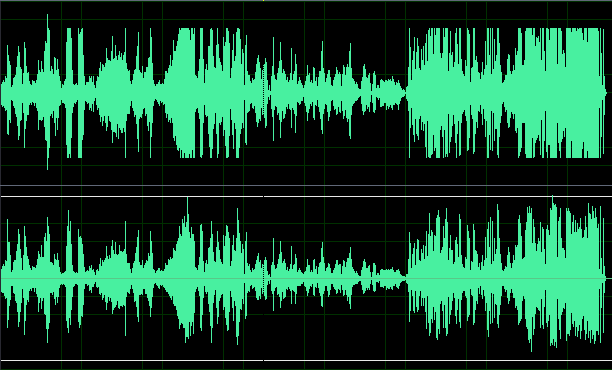Back
EMI's
Horribly Transfer

The image above is a screen capture from
Adobe Audition of one track of a French EMI set released in 2003. The source was monaural
from 1958 and the result is a travesty of professional transfer. I note that there were
nearly 100 monaural tracks on this ten-CD set. Some were better, some worse, but none was
free of the sorts of problems illustrated here.
Listening to this track, I was disturbed.
There was audible distortion, unbalance between channels and a moving image. I pulled the
LP from my library and, sure enough, it was undistorted, balanced and had a stable image.
To try to determine what was wrong, I extracted the track into Adobe Audition and my fears
were confirmed. In fact, I can see in my mind's eye what the engineer did.
Not visible in this view, there is also
evidence that the two channels are slightly out of phase, making it likely that a phono
cartridge was misaligned or a stereo play head with incorrect azimuth was used on the
master tape. In either case, there would be a penalty to pay in high-frequency response; I
had no way to assess that and no good way to correct for it.
Let's go to a speculative sequence of
events. Seeing that first peak, the engineer was afraid that he'd get saturation, so he
threw in a limiter on the left (upper) channel. Hey, who'd notice? Sure enough, the
limiter was needed - those right-channel peaks would definitely have driven the left
channel into saturation and hard clipping. Of course, he could have balanced
channels at lower gain and remade the track, but that would have taken an extra minute or
two. Regardless, he left the setup unchanged for the next track as well.
The stereo tracks also had unbalance and
clipping, but nothing as clear as on the monaural ones - and nothing as readily corrected.
I did take the effort to make what repairs were possible. For each monaural track, I
selected the channel that was less bad, altered level as needed and reduced clipping. Of
course, it would have been a lot easier to work with undistorted input - the original
signal source of tape or LP - and that would give far better results. But that was the
engineer's job; the best I could do was reduce his damage and produce something that
doesn't sound much worse than the LP.
WWW.261.gr